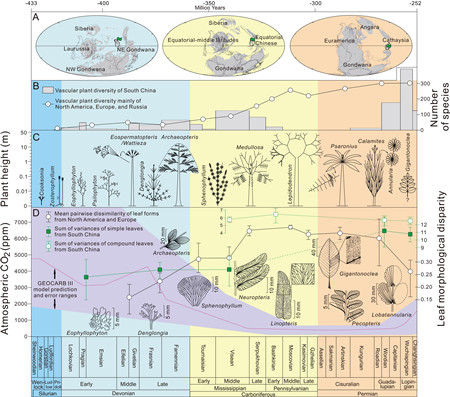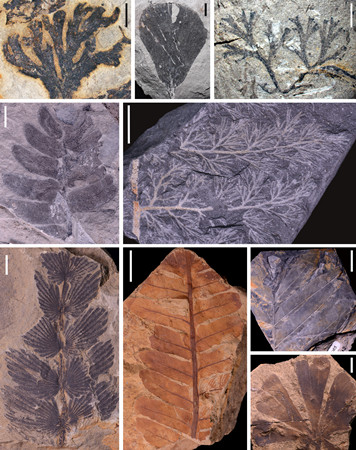Peking University, June 11, 2015:
The origin of vascular plants, more than 400 million years ago, changed the surface of our planet forever.
Beginning with small, simple, and grass-like ancestors, vascular plants (land plants that have lignified tissues for conducting water and minerals) evolved a huge variety of body plans. The conquest of land by early plants contributed to the establishment of the first terrestrial ecosystems and biogeochemical cycles.
Their astounding diversity - including 250,000 extant species ranging from clubmosses to sunflowers and from grass clumps to gigantic trees - is an example of a major adaptive radiation, where organisms diversify rapidly into a multitude of new forms.
A new study in the prestigious journal Earth-Science Reviews attempts to answer a number of questions relating to plant evolution.
Academics from Peking University, the University of Lincoln, UK, and the University of Bristol looked in detail at patterns of shape diversification in the leaves of early vascular plants, using a dataset of more than 300 fossil species from South China, ranging in age from 400 to 252 million years ago.
Key to the success of vascular plants is the origin of leaves, their primary light-harvesting organs. Leaves come in a huge variety of shapes and sizes, but how was this diversity attained? Did it reflect key environmental and climatic changes? And did modifications in leaf structure follow similar patterns around the world?
The team, led by Dr Jinzhuang Xue (Peking University), Dr Marcello Ruta (University of Lincoln), and Professor Mike Benton (University of Bristol), examined dozens of traits describing leaf shape and proportions, venation patterns (arrangement of leaf veins), and many others. The scientists were able to identify a stepwise increase in the complexity of leaves, marking two distinct phases in the evolution of early vascular plants.

Dr Xue explained: “During the first phase of plant evolution, from 400 to 320 million years ago, plants began to invade largely empty ecological spaces, and this process was presumably favoured by the lack of intense competition. In this phase, the complexity of simple and compound leaves increased gradually, in tune with an increase in species richness, an elaboration of plant body’s architecture, and the appearance of several floral types, such as shrubs, lianas, groundcovers, and trees of various sizes. During the second phase of plant evolution, from 320 to 252 million years ago, simple leaves increased again in complexity, while the complexity of compound leaves appeared to stabilize. New plant groups made their first appearance, particularly climbing and scrambling plants of humid habitats with leaves resembling those of several modern flowering plants in size, shape, and venation. Towards the end of this phase, we see a twofold increase in species richness, but no further expansion in the range of leaf types.”
Professor Benton said: “The study has revealed other unexpected findings. First, some groups of early vascular plants from South China developed large laminate leaves (leaves with a conspicuous blade) much earlier than their close relatives in Europe and North America. Second, despite a drop in species diversity some 320 to 300 million years ago, the complexity of leaves remained unaffected during that interval.”
Dr Ruta added: “Overall, species richness and leaf complexity appeared decoupled during the 150 million years of evolution of early terrestrial plants from South China. Considerable experimentation drove initial stages of plant evolution in ecologically undersaturated and low-competition landscapes, with key changes occurring in plant anatomy and physiology including a remodelling of leaf architecture. Later stages of plant evolution witnessed massive changes in floristic composition, an explosion of plant types apparently matching the expansion of wetland communities, and increased specialisations in ecological roles of different plant groups.”
- ENDS -
Reported by: Marie Daniels, Marcello Ruta
Edited by: Zhang Jiang
Links:

